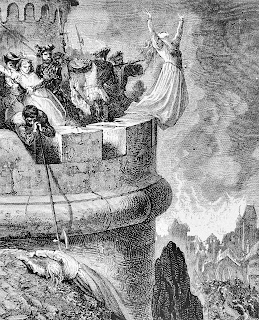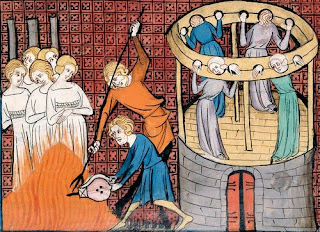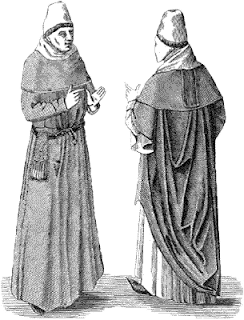The first witch trials in Switzerland and France occurred in 15th century. According to the historian Norman Cohn, the early accounts of the witch trials in France in the 13th and 14th centuries were forgeries.
 |
| Massacre of the Waldensians of Merindol in 1545 |
The stereotype of the witch as someone who flew at night to Sabbaths was not sanctioned by the Church until the 15th century when trials occurred in the areas of French and Swiss Alps as a result of the persecution of a group of Waldensian heretics.
In 1428 the peasant communities of the Swiss canton of Valais, under the guidance of the Bishop of Sion, declared that anyone accused of witchcraft by more than two people should be arrested and made to confess. Based on their confessions they were condemend to the flames.
A witch hunt began at the same time in the Val d´Anniviers and the Val d´Herens, two valleys south of the Rhone. This was the first time that the stereotype of the witch that would come to inspire the great witch hunt appeared.
In 1453 the sensational witch trial took place in Evreux, Normandy. Guillaume Adeline, a doctor of theology and former Paris proffessor, was accused of writing a compact with Satan binding him to preach sermons against the reality of the Sabbaths.
 |
| Torturing and executing witches in 14th century |
This was allegedly supposed to have the effect that judges would be discouraged from prosecuting those who went to Sabbaths, thus allowing more members to frequent such gatherings. Adeline confess to a compact with Satan. He said that he had flown on a broomstick to the Sabbaths and had found there a demon called Monseigneur, who change himself into a he-goat, and whom Adeline kissed under his tail as homage. Adeline was sentenced to perpetual imprisonment rather than death perhaps because of his position.
 |
| Guillaume Adeline |
Adeline was supposed to be a sect member of Waldensians, but Cohn notes that by this time the term was generally used as a synonym for ´witches´.
The northen and eastern regions and parts of the south-west of France were the most affected by witchcraft. The prosecution of witches may have been part of a general disciplinary program for controlling rebellious outlying regions. Courts in these far-flung places had great independence from central government, but when a central monarchy was established in 16th and 17th centuries, there were fewer witch executions.
0 comments:
Post a Comment